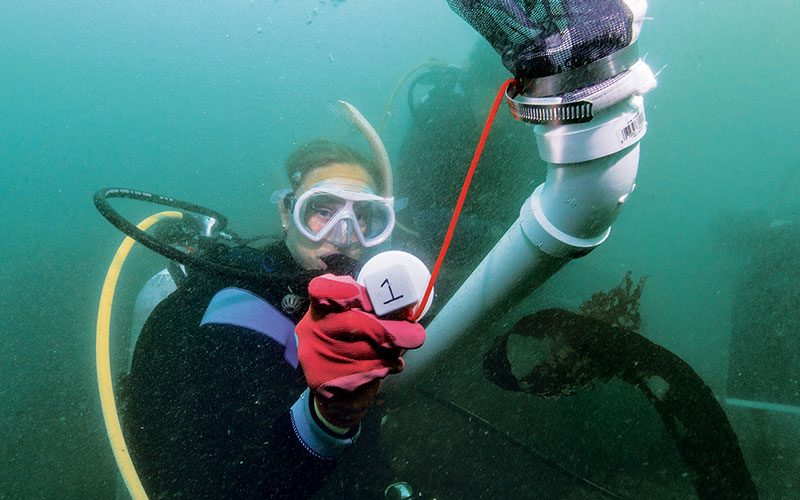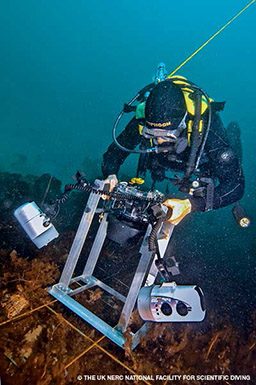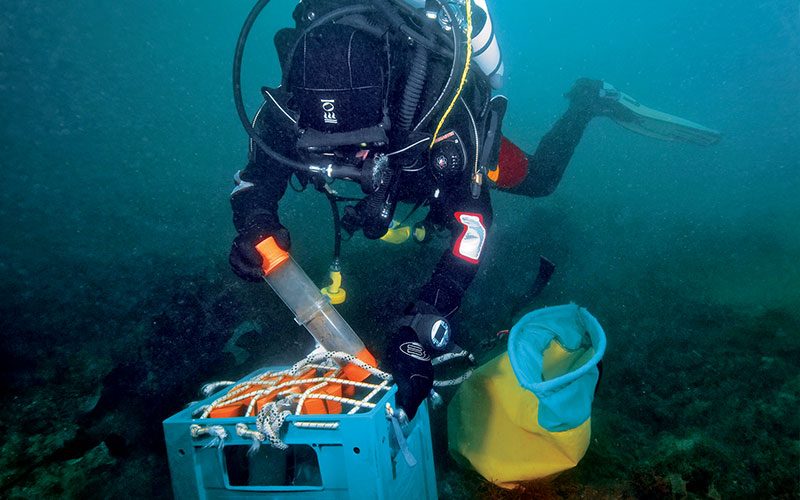Diving is unusual for the breadth of applications it can support. From entry-level recreational tours to hardcore recreational-technical excursions and from uncomplicated commercial projects to offshore saturation, the reasons people spend time underwater are innumerable and varied. Law enforcement, coast guard, and military services all have a toe or an entire leg in the diving realm. Photographers use diving for everything from point-and-shoot dalliances to commercial movie productions. And those movie productions may require diving not just by cinematographers, but by the cast, construction workers and safety personnel. An even broader use of diving is to support science.
Scope
Scientific diving is diving conducted as part of scientific research or educational activity, generally under the auspices of a scientific diving program. Scientific dives are conducted worldwide, using a variety of methods to address a wide range of goals. The finprints of scientific divers can be found from tropical to polar waters, and from well below sea level to altitudes approaching 20,000 feet. The biological sciences rely heavily on scientific diving, both for in-situ studies such as those popular in ecology and for sample collecting to support almost every conceivable subdiscipline. Chemistry, especially natural products chemistry, relies heavily on underwater collections to discover new compounds. Moving further afield, archaeology has a strong presence underwater, both for shipwreck and submerged terrestrial site studies. Speleology and hydrology incorporate a great deal of diving for the study of caves and water. Many other scientific fields also have a presence.

Scientific diving is conducted both shallow and deep, under ice, and far back in caves, in pretty much any situation in which water can be accessed by creative scientists. What is interesting given this remarkable range is the strong record of scientific diving safety. A recent review of 10 years of scientific diving conducted by organizational members of the American Academy of Underwater Sciences (AAUS), a US-based association with membership primarily comprised of institutions with scientific diving programs, captured over one million dives with a very small number of accidents.1 The sample included 33 cases of decompression illness (DCI) — the collective term for decompression sickness (DCS) and arterial gas embolism — for a DCI incidence rate of 0.324 per 10,000 person-dives. While the data for other forms of diving are incomplete, DCS estimates range from 0.9 to 35.3 per 10,000 person-dives. There are likely a number of reasons for the relatively good safety record of scientific diving. Most of the standards followed have evolved from years of thoughtful experience in a community, the choice of dive sites is usually retained by the scientist-diver, and it is relatively rare for dives to be necessary in conditions that offer a less-than-comfortable margin beyond acceptable. This reality is far different from that of some commercial and military operations. The oversight of scientific diving operations also provides a safety net not matched in most recreational diving activities.
Leadership

Many scientists come to diving primarily as a means to advance their science. Some continue to use it as simply another tool to facilitate their work. Others may more fully embrace the diving, and even gravitate to a greater focus on the diving and diving safety than the science. The latter group may provide the best pool of potential diving officers, the individuals responsible for the day-to-day administration of all divers and projects in the scientific diving program. The experience of appreciating the scientific approach, knowing how scientists think, what they need to achieve their ends, and, often most importantly, how to reconcile the scientific motivation with training and safety needs, is a powerful capability. Should mission creep ever lead scientific divers toward questionable decisions, the diving officer (who often trains and certainly monitors and periodically evaluates the program’s divers) stands by as a conscience to remind everyone of the priority of safety.
Diving officers generally work under the oversight of a diving control board (DCB), a panel normally made up of senior diving scientists and institutional representatives such as a medical officer. While the DCB can direct events, it is typically the diving officer who has the greatest impact on the character and operation of the program. An individual with the right combination of expertise, leadership, teaching ability and motivation can navigate the challenges to ensure that divers are appropriately trained, making good decisions, submitting necessary documentation and retaining their currency — all to meet standards and avoid accidents. Diving officers, like other safety professionals, are in the position that if they do their jobs well, they help ensure that nothing, or rather nothing untoward, happens. All the critical assessment, planning, training, monitoring and anticipation establishes an umbrella of protection. A good diving program will have a culture of thoughtfulness, low stress and safe operations with great institutional support. Each of these aspects is necessary for a program to flourish over time.
Evaluation
The evaluation of scientific diver competency can be an interesting challenge. Working scientists are busy, often disliking mandates to disrupt their activities for pool or classroom sessions. More importantly, such sessions are unlikely to represent the normal working conditions of the dive team. Artificial conditions are less effective at testing divers’ true capabilities, and the diving officer misses the opportunity to see the specifics of operations that are impossible to assess in summary documentation or highly constrained scenarios. The most effective strategy of a good diving officer, and probably the most enjoyable approach, is to join research teams in the field.

Field evaluations can be effective when offered as a convenience to the dive team. One method is for the diving officer to volunteer to assist with normal operations on the day for the small price of having the team participate in skill evaluations at the end.2 The diving officer assists with regular activities to keep the day productive while quietly evaluating normal operations of the team. This provides insights into crew performance and the needs of the scientific work. As an additional benefit, the time can also refresh some skills that the diving officer does not use on a daily basis, a useful element since the one providing oversight can sometimes be independent of the same protection. Running drills and emergency simulations at the end of the working day provides a better sense of performance with a normal degree of fatigue. Less-than-stellar performance under realistic conditions is more likely to capture the attention of a diver or dive team — it is more difficult to ignore problems evident in a normal day than a simulated one.
The completion of field evaluation days is often extremely satisfying. The cost, particularly for diving officers working in environmental health and safety offices with staff from multiple disciplines, is that it is hard for colleagues to resist a niggling (or greater) sense that these are boondoggle days. The best way to combat that is to have at least one other safety officer with some dive training to participate in one of the field evaluations. My favorite day of this type was when a fit — but minimally experienced with diving — safety officer who had agreed to be cross-trained declared in a staff meeting that the “boondoggle” day constituted the hardest work he had experienced in his career as a safety officer. It would, of course, have become much easier as he gained experience, but when part of the office time you have to justify is in the ocean it is sometimes best to promote a few illusions.
A good way to investigate potential careers in diving health and safety is to join an existing scientific diving program. While this may be easiest for students at institutions with programs, nonstudents may also be able to join, often initially as volunteer divers. This can be the gateway, providing experience and training and, if the fit is good, more opportunity. Those who enjoy the challenge of holding all of the pieces together to maintain a safe diving program could find a very satisfying career path.
References
1. Dardeau MR, Pollock NW, McDonald CM, Lang MA. The incidence of decompression illness in 10 years of scientific diving. Diving Hyperb Med. 2012; 42(4): 195-200.
2. Ma AC, Pollock NW. Physical fitness of scientific divers: standards and shortcomings. In: Pollock NW, Godfrey JM, eds. Diving for Science 2007. Proceedings of the American Academy of Underwater Sciences 26th Symposium. Dauphin Isl, AL: AAUS, 2007: 33-43.
© Alert Diver — Q2 Spring 2014